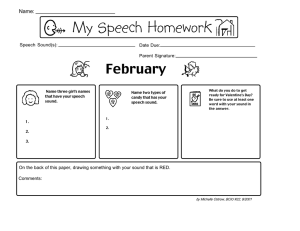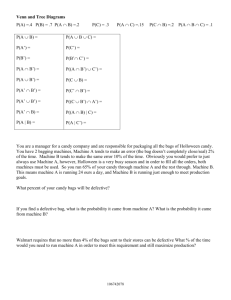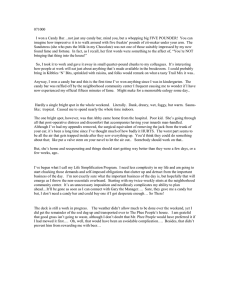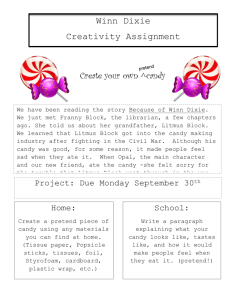Sample Questions and Mark Schemes www.XtremePapers.com
advertisement
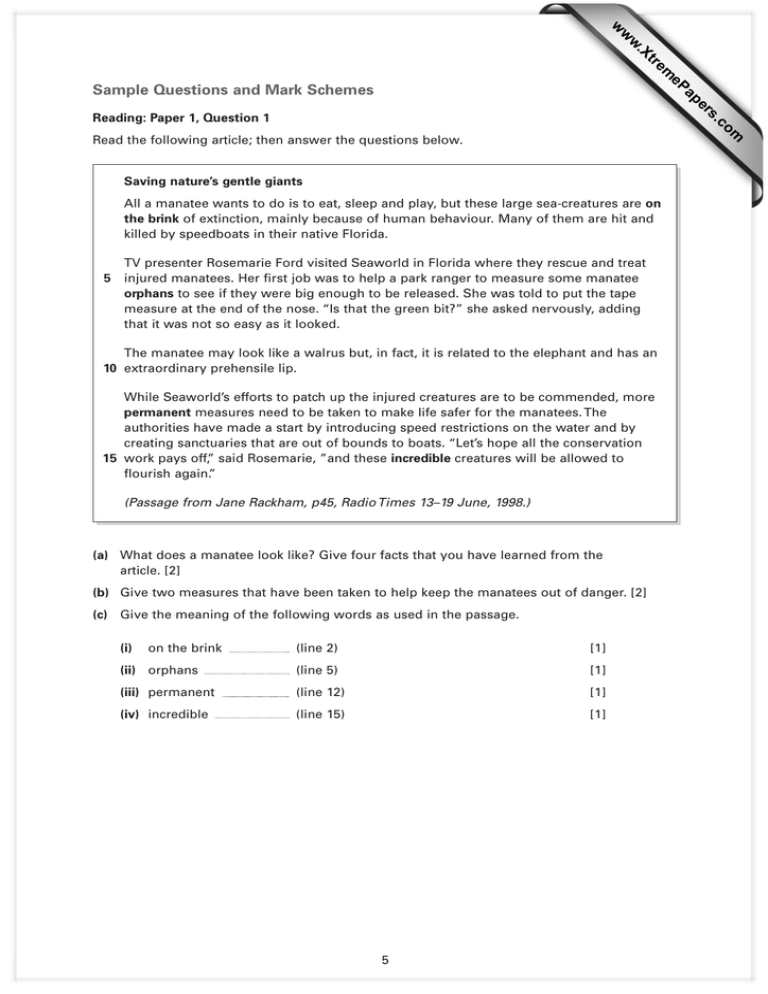
w w ap eP m e tr .X w Sample Questions and Mark Schemes s er om .c Reading: Paper 1, Question 1 Read the following article; then answer the questions below. Saving nature’s gentle giants All a manatee wants to do is to eat, sleep and play, but these large sea-creatures are on the brink of extinction, mainly because of human behaviour. Many of them are hit and killed by speedboats in their native Florida. 5 TV presenter Rosemarie Ford visited Seaworld in Florida where they rescue and treat injured manatees. Her first job was to help a park ranger to measure some manatee orphans to see if they were big enough to be released. She was told to put the tape measure at the end of the nose. “Is that the green bit?” she asked nervously, adding that it was not so easy as it looked. The manatee may look like a walrus but, in fact, it is related to the elephant and has an 10 extraordinary prehensile lip. While Seaworld’s efforts to patch up the injured creatures are to be commended, more permanent measures need to be taken to make life safer for the manatees. The authorities have made a start by introducing speed restrictions on the water and by creating sanctuaries that are out of bounds to boats. “Let’s hope all the conservation 15 work pays off,” said Rosemarie, ”and these incredible creatures will be allowed to flourish again.” (Passage from Jane Rackham, p45, Radio Times 13–19 June, 1998.) (a) What does a manatee look like? Give four facts that you have learned from the article. [2] (b) Give two measures that have been taken to help keep the manatees out of danger. [2] (c) Give the meaning of the following words as used in the passage. (i) on the brink (line 2) [1] (ii) orphans (line 5) [1] (iii) permanent (line 12) [1] (iv) incredible (line 15) [1] 5 Mark Scheme for Paper 1, Question 1 Understand explicit meaning Question Mark Answer (a) 2 What does a manatee look like? Give four facts that you have learned from the article. • they are giants (big) • look like walrus • have an unusual lip • have a green (nose); are partly green Give one mark for two or three correct answers Give two marks for four correct answers Allow lifting from the original (b) 2 Give two measures that have been taken to help keep the manatees out of danger. • they have made boats travel more slowly • they have provided safe places where boats cannot go Give one mark for each correct answer Allow lifting from the original (c) (i) 1 on the brink • about to be/almost (ii) 1 orphans • without parents (iii) 1 permanent • lasting/long-term/that will last (iv) 1 incredible amazing/unbelievable/magnificent/wonderful Give one mark each if the answer is a recognisable match to the mark scheme 6 Reading: Paper 2, Question 1 Candy has fallen over in the street and has hurt her ankle badly. Everyone is in a hurry and for a moment, no one helps her. This story was written in South Africa at a time when blacks and whites were required by law to live separately. Almost immediately she felt a tentative touch on her arm. She opened her eyes to see a young African girl standing directly in front of her, her face almost level with her own. Instinctively, Candy’s grip on her bag tightened. The girl could be after her money. Candy knew how nimblefingered the young black pickpockets in the city were reputed to be; she was forever being warned to keep a close hold on her purse. “You okay?” Without waiting for an answer, the girl bent down to inspect Candy’s ankle. “Tch… tch… shame.” Shaking her head sorrowfully, she straightened up. “That’s no good to walk on,” she decided. “It’ll be all right. I’ll sit down for a few minutes, then I’ll be okay.” Candy smiled thinly, her eyes still warily watching the girl’s every move. Shyly, the girl grinned back. “You can sit down in the park,” she said. “It’s not too far.” “Yes, I’ll do that. I’ll be all right now… thank you.” Just then somebody bumped the girl’s shoulder, causing her to stagger forward close to Candy. “Too many people,” she said, her grin broadening to show sparkling white teeth. “Yes.” Candy’s fingers had tightened even more firmly round her bag. Bracing herself, she put a little weight on her left leg and then grimaced as pain flared through her ankle. “Oh, I must help you.” Hesitantly, the girl took hold of Candy’s free arm, and after a momentary reluctance, Candy cautiously allowed herself to be supported as they began to move slowly along the gutter. “Come on, I’ll race you!” the girl joked. Candy managed a laugh, then felt herself blushing as she became aware of the curious stares they were attracting. She tried to hobble faster, leaning as little as possible on the supporting arm beside her. She still wasn’t sure she could trust the girl; and anyway, she didn’t like being under an obligation to her. It would have been so much simpler if it had been a white person who had offered help. She didn’t know why the girl was doing it. Should she offer to pay her? It was all rather embarrassing. The park was only two blocks away, but it seemed an age before they got there. As the girl helped her down into a sitting position on the grass, Candy was aware of her bag slipping off her shoulder and the girl stretching out to catch it as it fell. Candy held her breath, her heart racing. But the girl didn’t run off. Instead, she waited until Candy was sitting comfortably, and then handed the bag down to her. “Better now?” she asked. Candy could only nod, feeling ashamed. The girl turned away and crouched down to take a closer look at the injured ankle. While she explored the swelling with careful, gentle fingers, Candy studied her thoughtfully. She was really rather pretty, Candy discovered somewhat to her surprise, for she had never thought of African features as being particularly attractive before. But this girl’s features were all in perfect proportion to each other, giving her face as a whole an open, sunny expression. 7 The girl looked up and caught Candy staring at her. Grinning foolishly, Candy asked, “Well, do you think I’ll live?” The girl also grinned. “For sure, I can’t say. Maybe.” She had very large, deep brown, glowing eyes. Full of mischief, Candy thought. But an instant later the eyes had darkened into seriousness. “Is it very sore?” the girl asked, scrunching up her face as if she was in pain herself. “No, it’s much better now. Thanks so much for all your help. I don’t know what I would have done without it.” “It’s nothing.” The girl stood up shrugging, and smoothed down her faded, floral-patterned skirt which Candy noticed had a large patch near the hem. It occurred to Candy that the girl might think she was trying to get rid of her, not needing her help any more. But Candy didn’t want her to go. She had never met an African girl of her own age before – at least not to speak to. And she was already beginning to like the slender, gawky figure in front of her who seemed undecided about her next move and was fidgeting nervously with the frayed collar of her blouse, trying to do up a button that wasn’t there. “Are you in a hurry?” Candy asked. “No. Why? Can I give you a lift home? My Mercedes is just round the corner.” Candy laughed and that apparently decided the girl. She flopped suddenly, all limbs and awkward angles like a puppy, on to the grass beside Candy. “What’s your name?” she asked. “Candice. But everyone calls me Candy. And yours?” “Rebecca. But everyone calls me Becky.” And then they both laughed. Extract from ‘Go well, stay well’, Toeckey Jones, published by Heinemann New Windmill Series, 1987. (a) Give four things that you learn about the personality of Becky, the black girl, from the way she behaves in this passage. Support each of your answers with evidence from the story. [8] (b) Give four words from the passage that suggest that Candy’s injury is painful. Explain how each word you have chosen makes you think that the injury is painful. [8] (c) The moment when Candy’s bag slips off her shoulder and Becky stretches out to catch it is a turning point in the story. Using your own words, give two examples of how Candy feels about Becky before this incident and two examples of how Candy feels after this. Explain each of your answers using evidence from the story. 8 [8] Mark Scheme for Paper 2, Question 1 Comment on character in narrative Question Mark Answer 1(a) 8 Give four things that you learn about the personality of Becky, the black girl, from the way she behaves in this passage. Support each of your answers with evidence from the story. Personality Evidence 1 Kind/helpful (to Candy) “You okay?” “I must help you.” Stopped to attend to her. 2 Sensible/practical (about the injury) “That’s no good to walk on.” “Too many people.” Seemed to know about Candy’s injury. 3 Grinned a lot/sunny expression “Broadening to show sparkling white teeth.” Grin mentioned three times. 4 Sense of humour/a tease Jokes; “Come on, I’ll race you!”; answer to “do you think I’ll live?”; “My Mercedes is just round the corner.” Eyes full of mischief. 5 Gentle/sensitive Her “supporting arm”; “explored the swelling with careful, gentle fingers.” 6 Could feel others’ pain/sympathetic “Scrunched up her face as if she was in pain herself.” 7 Nervous/shy “Tentative touch”, her grin was shy. 8 Friendly/non-racist Went to help and touch Candy although she was white; shared names; laughter; talked openly; cracked jokes; no formality. 9 Trustworthy Becky “did not run off’ with the bag but “handed the bag down to her”. 10 Patient She helped her to the park “two blocks away” and “it seemed an age”. Give one mark per answer and one per piece of evidence. Comment the writer’s use of language Question Mark Answer 1(b) 8 Give four words from the passage that suggest that Candy’s injury is painful. Explain how each word you have chosen makes you think that the injury is painful. Answers may include Explanations 1 grimaced her expression was distorted by the pain 2 hobble pain prevents easy/normal movement; word pictorial of unsteadiness 3 swelling all swellings round joints make movement painful 4 scrunching another word for “grimaced” – says “as if she could feel pain herself” 5 cautiously because aware that normal movement might be very painful 6 thinly not a real smile (because it was painful) 7 flared it was a surge of pain – like fire Give one mark per word and one per explanation. 9 Understand implicit meaning Question Mark Answer 1(c) 8 The moment when Candy’s bag slips off her shoulder and Becky stretches out to catch it is a turning point in the story. Using your own words, give four examples of how Candy feels about Becky before this incident and four examples of how Candy feels after this. Before Explanation of Answer 1 suspicious that black girls steal/couldn’t trust her 2 embarrassed she shouldn’t be seen with/holding on to Becky 3 superior that she ought to pay her/didn’t like feeling under an obligation to her 4 confused by the fact that (help came from a black girl) she was black After Explanation of Answer 5 ashamed/ trusted her because Becky didn’t steal the bag/returned it 6 started to realise that Africans were good looking because Becky’s expression was “sunny”/fine eyes 7 wanted her to stay starting to like her/her mannerisms 8 laughed with her ALSO shared names Give one mark per answer and one mark for evidence based on the story to a total of 4 in BEFORE, and do the same in AFTER, totalling 8. 10 Reading Summary: Paper 1, Question 2 Read the following account of the sinking of the Titanic, written by a survivor. We did not begin to understand the situation until we were perhaps a mile or more away from the Titanic. Then we could see the rows of lights along the decks begin to slant gradually upwards from the bow. Very slowly the lines of light began to point downward at a greater and greater angle. The sinking was so slow that you could not perceive the lights of the deck changing their position. The slant seemed to be greater every quarter of an hour. That was the only difference. In a couple of hours though she began to go down more rapidly. Then the fearful sight began. The people in the ship were just beginning to realise how great their danger was. When the forward part of the ship dropped suddenly at a faster rate, so that the upward slope became marked, there was a sudden rush of passengers on all the decks towards the stern. It was like a wave. We could see the great black mass of people in the steerage sweeping to the rear part of the boat and breaking through into the upper decks. At the distance of about a mile we could distinguish everything through the night, which was perfectly clear. We could make out the increasing excitement on board the boat as the people, rushing to and fro, caused the deck lights to disappear and reappear as they passed in front of them. This panic went on, it seemed, for an hour. Then suddenly the ship seemed to shoot up out of the water and stand there perpendicularly. It seemed to us that it stood upright in the water for four full minutes. Then it began to slide gently downwards. Its speed increased as it went down headfirst, so that the stern shot down with a rush. By: Mrs D H Bishop Extract from ‘Faber book of Reportage’, edited by John Carey, published by Faber & Faber, 1987. Mrs Bishop describes each stage of the sinking of the Titanic. Write a summary of her account of what happened to the ship. Write about 70 words. Use your own words, as far as possible. 11 Mark Scheme for Paper 1, Question 2 Select and summarise information and ideas Question Mark Answer 2 8 Write a summary of her account of what happened to the ship. 1 the ship tilted downwards/the lights pointed downwards 2 gradually increasing 3 so slowly you could hardly notice 4 for about two hours 5 then it started to drop more quickly 6 going down forward, with the stern upwards 7 for about an hour 8 then it shot up out of the water/quickly/without warning 9 stood straight up (as on its end) 10 for four minutes 11 finally it slid down into the water 12 slowly at first 13 very fast at the end Tick and number points. Award 2 marks for each section. Do not reward reference to what the people on board did. If the summary is mainly copied and/or unduly long, deduct 1 or 2 marks. 12 Writing: Paper 1, Question 3 Your school is going to organise a project to improve the appearance of somewhere in the locality and to make it more useful for everybody. Write your suggestions for the project, to be handed to your principal. Set out your answer in two paragraphs. In the first paragraph, describe the place as it is now. In the second paragraph, explain what you would do to improve it and what it would be like when you had finished. Structure [7] Style [4] Audience [4] Sentence structures [7] Spelling [4] Punctuation [4] Total marks [30] Write about one page. Mark Scheme for Paper 1, Question 3 • Structure content (7) • Use a style suited to purpose and form (4) • Write with a sense of audience (4) • Use a range of sentence structures (7) • Spell correctly (4) • Punctuate correctly (4) Please see table on page 14. 13 14 3 1 Style often unclear; impeded by poor command of language. 2 Sometimes unfocused, or unclear. Occasionally fluent. Explanatory – mostly clear, occasional awkwardness. 4 4 Glimmer of understanding that the audience exists. 1 2 Occasionally aware of audience, though most writing neutral (e.g. unattractively factual). 3 Some sense of understanding of a need to communicate a sense of place and of purpose. Clearly suited tone; authoritative, consistent. Audience Award 0 if performance fails to meet the lowest descriptor. 1 Possibly unparagraphed or inadequately so. Material ineffectively list like or in random order. 2/3 Paragraphed, tends to be a series of items rather than cohesive and developed. 4/5 Paragraphed, some sense of introduction. Usually ordered within paragraphs. Very clear, explanatory, fluent. Paragraphed, clear topic sentence paragraphs linked; material well sequenced and managed. 6/7 Style Structure 6/7 A few spelling errors, mostly of more difficult words OR virtual correctness over simple vocabulary OR spells more complicated words correctly but makes errors over 3 simpler words. 4 Virtual correctness over range of vocabulary used, including more complex and difficult words. Spelling 1 1 Sentence structures are Many errors including limited to simple or a range of simple compound forms liable words. to fragment at some points. Limited or partially effective A number of errors, use of complex sentences. sometimes of quite Mostly simple or simple words. compound structures; based on “and”, “but”, and “so”. May attempt complex sentences but writes shapelessly. 2/3 2 4/5 Shows some ability to vary sentence forms including a use of complex sentences. Fluent, demonstrating a skilful use of complex and simple sentences. Begins to use range of grammatical features for effect. Sentence Structures 1 Sentences usually correctly marked. Little use of other simple punctuation marks. Sentences mostly use full stops and capitals. Begins to use commas, apostrophes and question marks correctly, but range limited. 2 Punctuation of full stops and commas generally correct. Shows awareness of need to use punctuation to aid the reader’s understanding, but range a little limited. 3 4 Correct over a range; used to define meaning. Punctuation Writing: Paper 2, Question 2 Imagine you come face to face with a creature that scares you. Write from the moment you see it watching you, describe your feelings clearly, and say what happens (or might happen) next. You may write about a real experience if you like and the creature may be of any size. Content Style Audience Vocabulary Spelling Punctuation Total marks Write about a page. Mark Scheme for Paper 2, Question 2 • Use appropriate subject matter (7) • Use a style suited to purpose and form (4) • Write with a sense of audience (4) • Use a range of vocabulary (7) • Spell correctly (4) • Punctuate correctly (4) Please see table on page 16. 15 [7] [4] [4] [7] [4] [4] [30] 16 5/6 1/2 2 3 4 1 Style often unclear; impeded by poor command of language. Descriptive, sometimes inconsistent or unclear. Occasionally fluent. Mostly clear, with occasional awkwardness. Clear, entertaining, fluent. Style Glimmer of more understanding that the audience exists. 1 1 Uses a simple vocabulary competently but may make errors over more complex words. Vocabulary generally used accurately, consists of straightforward words with occasional evidence of careful choice. 2/3 Occasionally aware of an audience, though most writing neutral (e.g. little attempt to convey the exact nature of the incident). 2 4/5 Some evidence of an emerging vocabulary; efficiency in the choice of words to convey details. 3 Some sense of the awareness needs of the reader (e.g. some success in drawing the reader into the story). 6/7 Plenty of exact, interesting vocabulary that conveys detail, not generality. Consistently aware of the need to interest the reader with detail and a voice. 4 Vocabulary Audience Award 0 if performance fails to meet the lowest descriptor. Not very much conveyed though what is said is relevant. 3/4 A competent but plain presentation of the incident and the creature itself. Describes the encounter fairly fully. May be less convincing in describing feelings. 7 Covers all the question, describing feelings, the creature, and providing interesting events. Content 1 Many errors including a range of simple words. 2 A number of errors, sometimes of quite simple words. A few spelling errors, mostly of more difficult words OR virtual correctness over simple vocabulary OR spells complicated words correctly but makes errors over simpler words. 3 Sentences mostly use full stops and capitals. Little use of other simple punctuation marks. 1 Sentences usually correctly marked. Begins to use commas, apostrophes and question marks correctly, but range limited. 2 3 Punctuation generally correct. Shows awareness of need to use punctuation to aid the reader’s understanding, but range limited. 4 Correct over a range; used to define meaning. Virtual correctness over range of vocabulary used, including more complex and difficult words. 4 Punctuation Spelling 17 18
